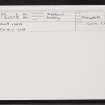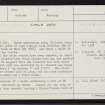Whalsay, Gamla Vord
Cairn (Bronze Age), Cist (Bronze Age), Flake (Flint)(Prehistoric), Hammerstone (Prehistoric)
Site Name Whalsay, Gamla Vord
Classification Cairn (Bronze Age), Cist (Bronze Age), Flake (Flint)(Prehistoric), Hammerstone (Prehistoric)
Alternative Name(s) Willie's Wart
Canmore ID 1312
Site Number HU56NE 8
NGR HU 58162 65043
Datum OSGB36 - NGR
Permalink http://canmore.org.uk/site/1312
- Council Shetland Islands
- Parish Nesting
- Former Region Shetland Islands Area
- Former District Shetland
- Former County Shetland
HU56NE 8 5818 6508
HU 582 652 (2). Cairn containing cist, Willie's Wart, on the highest point of land between Loch Isbister (HU 57 64) and West Loch of Skaw (HU 58 66) and about a third of a mile SW of the latter.
Almost all the cairn stones have been removed, no doubt to build the plantie-crub which stands hard by, but sufficient remains to suggest that the diameter has been about 23'. The slab cist was excavated by J. Stewart and found to measure about 4' by between 2' and 2'10". The floor
was of smaller stones laid on peat, and the cist contained
a rude hammer-stone and a flint flake.
RCAHMS 1946; C S T Calder 1963
The poor remains of a cairn containing a cist at HU 5816 6508, as described by RCAHMS. Almost all the body of the cairn has been removed leaving a discontinuous kerb of stones.
Visited by OS (NKB) 30 May 1968
Field Visit (27 May 1936)
Cairn, Willie's Wart.
This site is on the highest point of land between Loch Isbister and the West Loch of Skaw, about a third of a mile S.W. of the latter. Almost all the stones have been removed, no doubt to build a "plantie-krub" which stands hard by but sufficient traces remain to suggest that the cairn was originally about 23 ft. in diameter. In the centre, at the date of visit, was a setting of stones just showing above the turf and suggesting the presence of a cist. This cist has since been excavated by Mr. J. Stewart, who reports that its length was 4 ft. 4 in. on the. S.E. and 4 ft. 2 in. on the N.W. side, its breadth 2 ft. 10 in. at the N.E. and 2 ft. at the SW. end, and the depth of the slabs forming it from 1 ft. 3 in. to 1 ft. 10 ½ in. The bottom is made of smaller stones lying on peat. At the N.E. end of the cist, in a layer of grey soil, grit and fine sand, was found a rude hammer-stone and at the bottom of the layer a flint flake.
RCAHMS 1946, visited 27 May 1936.










